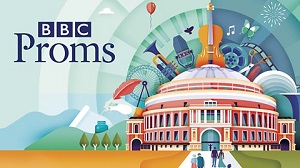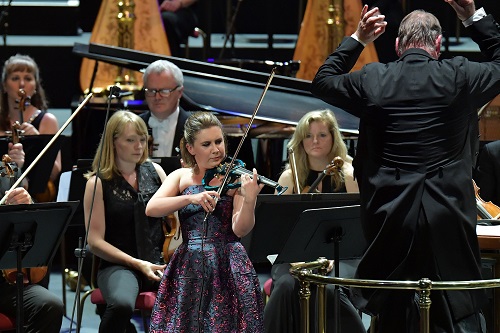
 United Kingdom Prom 16 – Dukas, Michael Berkeley, Prokofiev: Chloë Hanslip (violin/electric violin), Diego Espinosa (tabla), BBC National Orchestra of Wales/Jac van Steen (conductor), Royal Albert Hall, London, 27.7.2016. (CS)
United Kingdom Prom 16 – Dukas, Michael Berkeley, Prokofiev: Chloë Hanslip (violin/electric violin), Diego Espinosa (tabla), BBC National Orchestra of Wales/Jac van Steen (conductor), Royal Albert Hall, London, 27.7.2016. (CS)

(c) Chris Christodoulou
Paul Dukas: La Péri – Fanfare and Poème dansé
Michael Berkeley: Violin Concerto: In memoriam DR (BBC commission: world premiere)
Sergei Prokofiev: Romeo and Juliet Op.64
This Prom got off to a rousing start as the extended brass section of the BBC National Orchestra of Wales rose to their feet for the Fanfare to Paul Dukas’s 1912 ballet La Péri – a preface which was apparently added by the composer just before the premiere in the hope of encouraging noisy French audiences to quell their chatter.
Prom audiences need no such incentive to adopt good concert etiquette, and all eyes and ears were fully focused on a fanfare which was steady and sonorous – stately rather than swash-buckling – and which intimated some sense of the gravity of the journey which the mythic Iskender must make in search of the Flower of Immortality, a journey which will lead him to the ‘Ends of the Earth’ and a fateful encounter with a beautiful péri.
Though their ensemble was not always spot-on – the first chord wobbled a bit – the brass produced a lovely even tone and a rich variety of colours: the sombre trombones contrasted with the bright trumpets supported by sturdy tuba, followed by warm, ringing horns. There was mystery as well as majesty, though, as the harmonies slipped into eerie, unexpected realms before the final emphatic statement of the theme.
It was good to have an opportunity to appreciate the talents of the brass section, but in the ensuing Poème dansé en un tableau every individual had the chance to shine: so pointillistic is Dukas’s orchestration that each and every player is a soloist, with even the string sections divided into multiple lines, each treated independently. Van Steen made sure that we heard every contribution and the conductor had an excellent sense of the score’s dramatic range and musico-narrative structure. This was exquisite musical story-telling.
From the opening bars the dark stillness of the cellos’ and basses’ low pedal served as an anchor for the three-note horn motif and woodwind fragments which effect a gradual awakening and initiate us into the work’s exotic secrecies. There was a wonderful sense of anticipation and discovery. The Victoria and Albert Museum has just been gifted the world’s largest collection of paper peepshows, more than 360, and as van Steen guided his players through Dukas’s kaleidoscopic soundscape I was minded of the thrill of peering through a tiny tunnel to glimpse unknown and unimagined landscapes and treasures.
There was much fine playing to admire: delicately etched woodwind solos, a lilting dance for cellos and violas, whispery tremolo strings, tender repetitions of the horn’s motif, threatening percussion in the central martial episode. Van Steen controlled the ebbs and flows, moving fluidly between episodes, and had an instinctive feeling for the lazy hemiolas which seem to infer both insouciance and portent. The dances had power grace and power. Accelerandos and rubatos all felt completely natural, and just the entry of the two harps, with wafting triplets, could be enough brighten the shadows cast by ominous brass – as if the sun effortlessly shone through storm clouds. The return of the horn motif in the closing bars was magical and the beautifully placed final statements drifted into a final soft chord of gentleness.
Michael Berkeley’s Violin Concerto, commissioned by the BBC and given its world premiere here by Chloë Hanslip, was inspired by eclectic influences: according to the composer, an earlier composition for cello, Nigel Kennedy playing a Jimi Hendrix tribute at Ronnie Scott’s and Akram Khan’s use of the tabla in his ‘sculptures in movement’ (Berkeley has worked with Khan on the BBC radio programme, Private Passions) naturally coalesced into a 25-minute single-movement concerto, which is dedicated to Berkeley’s late wife, the literary agent Deborah Rogers.
There are quite a few double concertos but there can’t be many which ask a single soloist to play two instruments. This is what Berkeley’s new work demands, though, requiring Hanslip to play both her familiar 1737 Guarneri del Gesù and a six-string Violectra. Berkeley adds a tabla to the orchestral forces with Diego Espinosa Cruz González seated on a raised rug, to the right of van Steen.
Explosive thumps of a ritual drum interspersed with fragmentary percussive gestures made for a violent and volatile opening as Hanslip’s high acoustic violin line cleanly cut through the intermittent silences. Her introspective lament was played with a pure, concentrated tone and as the exploratory meanderings grew, increased vibrato swelled the sound through long held notes, creating an aching intensity. There was some lovely clean double-stopping, too, in a later cadenza-like episode. Gradually the harmonic background was filled, as throbbing textures murmured above a chromatically rising bass line. As the orchestration thickened the mood became more urgent, culminating in thunderous beating and a surging, full orchestral chord. An agitated section followed in which competing ostinatos destabilised the beat and the soloist’s line was troubled by stabbing brass and double bass pizzicato.
The central section of the concerto is more plaintive: a slow dance with the dulcet accompaniment of harps, celeste and the fuller texture of sustained strings. The consonant harmony is tinged with jazz nuances in the harp’s gliding ripples. Hanslip delved into a vein of Romantic lyricism, delicately ornamenting and soulfully singing the melody which is reprised from At A Solemn Wake, a work which Berkeley wrote for cellist Adrian Brendel shortly after Deborah Rogers’ death.
This calm and concord was gradually pushed aside by a repeated rising theme in the accompaniment, and before we knew it the thudding drum was back before it too was brutally eclipsed by the distorted screaming of the electric violin. Hanslip conjured an extraordinary tonal palette and enjoyed exploring the full range and timbral potential of the instrument. It must have been fun to soar so effortlessly over the orchestra. Spoken percussive interjections (bol) were provided by tabla player Diego Espinosa Cruz González.
The demented fury of this final section left this listener rather stunned; and the fragmentary accompanying motifs almost seemed to suggest that it was a challenge for the instrumentalists to articulate a musical response to this frenzied unleashing of rage and grief. Brass splattered repeating patterns and at one point the tuba tried to launch a counter-melody but the violin continued its cathartic outpouring. Stillness returned only with the reappearance of the central waltz theme, as the acoustic violin tried to rebuild the melody which, Berkeley explains, now ‘reveals its own source: the notes Back used to spell out the letters B-A-C-H in the closing bars of The Art of Fugue … and which simply stop mid-sentence’. Here, the ritual drum over-powered the theme and had the last word.
The BBCNOW rose to the technical and expressive challenges of the score and all concerned certainly communicated the profound emotions and experiences which the music undoubtedly embodies. But I wasn’t entirely convinced by the relationships between the diverse elements and voices of the concerto, and look forward to being able to listen to the work again during the next few weeks via the BBC’s iPlayer channel (Prom 16)
After the interval, the extended orchestral forces were further supplemented by piano, saxophone, organ and yet more percussion for excerpts from Prokofiev’s colourful ballet Romeo and Juliet. Van Steen’s selection focused on the ballet’s dramatic ensemble episodes so we had bustling streets, fights and dances, but neither Juliet nor Romeo were introduced to us until their balcony encounter, and the Nurse, Mercutio and Tybalt were similarly excluded from the line-up of protagonists.
A lush, warm string bel canto characterised the Introduction, contrasting with bright-toned, precise woodwind and the bustling energy of the rocking accompaniment figures. The staccatos of ‘Morning Dance’ bristled: there was a beguiling swing to the tempo, the energised cello pizzicato had lots of ping and the brass were breezy and exuberant.
The fiddles showed their mettle in the furious presto of ‘Fight’ – van Steen clearly took Prokofiev’s metronome mark at its word – while horns and tuba stamped ominously through their theme, before trumpets and oboe gave their own nose-thumbing riposte. Despite the huge forces van Steen attained orchestral transparency. Prokofiev’s skilful orchestration does a lot of the work, but the conductor found a welcome airiness and lots of rhythmic bite – the vicious percussive thuds culminated in four pounding quavers of spite. The Duke’s disapproval at this woeful public display was fully evident in the subsequent ‘Duke’s Command’ which quelled the fracas with a blast of menace: the accumulating dissonances exploded into furious thundering from the timpani before the subdued, sombre strings lapsed into exhausted stillness.
The ‘Dance of the Knights’ might have had more pesante punch, but there were some lovely solos from horn, cornet, clarinet and flute during the tranquillo episodes and some delicate, tripping pizzicato from the strings. Van Steen conjured wry classical grace in the ‘Gavotte’, employing judicious rubato and a good dynamic range; in the ‘Balcony Scene’ the harp twinkled without too much Hollywood schmaltz from strings.
A linking sequence from the end of the ballet rounded up the tragedy. The Interlude to ‘Friar Laurence’s Cell’ show-cased some strong horn-playing, while in the Friar’s cell it was the dark trio of string basses, contra-bassoon and tuba whose turn it was to shine, against the fragile tick-tocking of the upper woodwind. The string lines were nicely phrased and the flutes brought lucidity and lightness to ‘Juliet’s Bedroom’.
Van Steen seemed to seek out the music’s subtleties and sensitivity rather than its tragic darkness and fiery drama. The BBCNOW told the tale but the scenes did not spring vividly and dynamically to life – a cast of dancers was not summoned in my mind. This was a satisfying account but one which did not reprise the radiance of the orchestra’s performance of Dukas’s ballet earlier in the evening. Admittedly we were only given a smattering of the full drama, but by the time Juliet dies surely one should feel emotionally drained; one this occasion, I was dry-eyed.
Claire Seymour